Manage moisture effectively in natural heat cooking by working with your ingredients' water content – most produce contains around 80% water naturally. You'll get better results by grouping foods with similar moisture levels and using snug-fitting lids to trap steam. Control condensation by adjusting lid placement: fully covered for moisture retention or slightly cracked for controlled evaporation. Choose the right containers and monitor internal temperatures with a food thermometer to maintain ideal cooking conditions. For outdoor cooking, proper ventilation and strategic equipment placement make a significant difference. The journey to mastering moisture control leads to even more flavorful possibilities.
Understanding Solar Cooking Moisture Loss
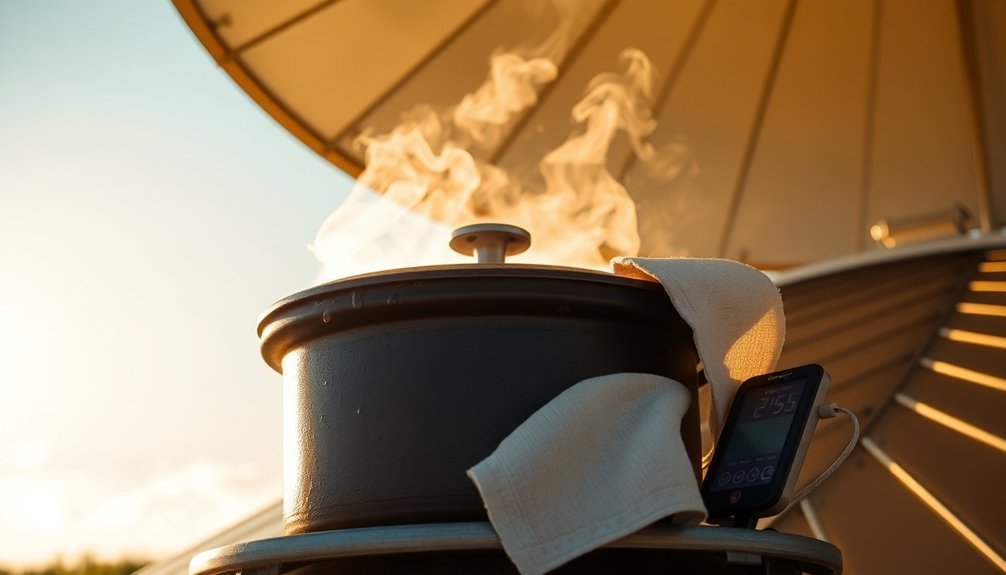
When using a solar oven, you'll notice that most foods naturally release moisture during the cooking process. This is especially true when you're cooking vegetables and meats, which tend to produce more condensation than other ingredients. Opening the lid frequently can cause up to 25 degrees of heat loss.
You don't need to add any extra liquid – the foods themselves will generate enough moisture.
Understanding how this moisture affects your cooking is essential. When water vapor builds up inside your solar oven, it can create a barrier on the glass lid that blocks sunlight from reaching your food.
This condensation can considerably slow down cooking times and reduce the temperature inside your oven. If you're monitoring your food's progress, you'll find that the moisture buildup on the glass can make it difficult to see inside clearly.
Water Content Ratios
The water content of your ingredients plays a key role in successful solar cooking. You'll find that fruits and vegetables contain varying amounts of moisture, from watermelons at 90% to bananas at 74%. Most produce averages around 80% water content, which directly affects your cooking process.
When you're planning your solar cooking, consider that high-moisture foods like tomatoes (94%) and celery (95%) will require more energy to process than drier ingredients. Double glazing can help maintain consistent temperatures needed for cooking water-rich foods.
You'll need approximately 464 watt-hours per pound to dry foods with 80% water content. To optimize your cooking, group ingredients with similar moisture levels together.
For better results, you might want to slice water-rich vegetables like zucchini thinner than drier items, ensuring more even cooking throughout your dish.
Steam Control Techniques
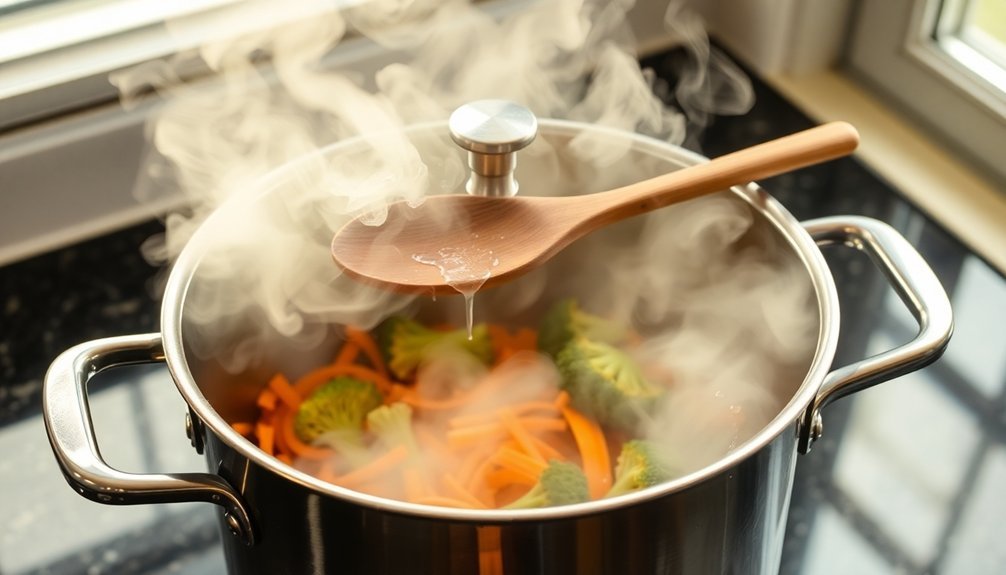
Managing steam effectively in your solar cooker requires understanding basic control techniques.
You'll need to monitor temperature and pressure levels carefully to achieve ideal cooking results. By controlling steam flow and maintaining proper pressure, you can guarantee your food cooks at precise temperatures. For example, at 2 bar pressure, you'll achieve a consistent 133.7°C, perfect for many dishes.
- Use a vortex flow meter to track steam content accurately
- Install culinary-grade filters to guarantee clean, filtered steam
- Position your steam basket above the water line
- Maintain a steady simmer for continuous steam production
- Adjust cooking times from 5 minutes for greens to 30 minutes for poultry
Remember to use snug-fitting lids to trap steam effectively and maximize heat transfer efficiency.
With proper control, you'll achieve better results while using less energy.
Lid Selection and Management
Selecting appropriate lids for your cookware directly impacts moisture control and cooking results. You'll find that full lids trap steam for moisture retention, while cracked or parchment paper lids allow controlled evaporation. For precise moisture management, consider both lid type and material.
| Lid Type | Best Used For |
|---|---|
| Full Lid | Braising, steaming |
| Cracked Lid | Reduction sauces |
| Parchment | Gentle browning |
| Glass | Visual monitoring |
| Metal | High-heat cooking |
When choosing lids, prioritize durability and handle comfort. Enamel cast iron offers excellent heat retention, while hard-anodized aluminum provides durability with less weight. You'll want to guarantee your lid fits snugly and allows for adjustments based on your cooking technique. For maximum flexibility, keep various lid types in your kitchen arsenal, including parchment paper for creating custom-sized covers.
Time and Temperature Adjustments
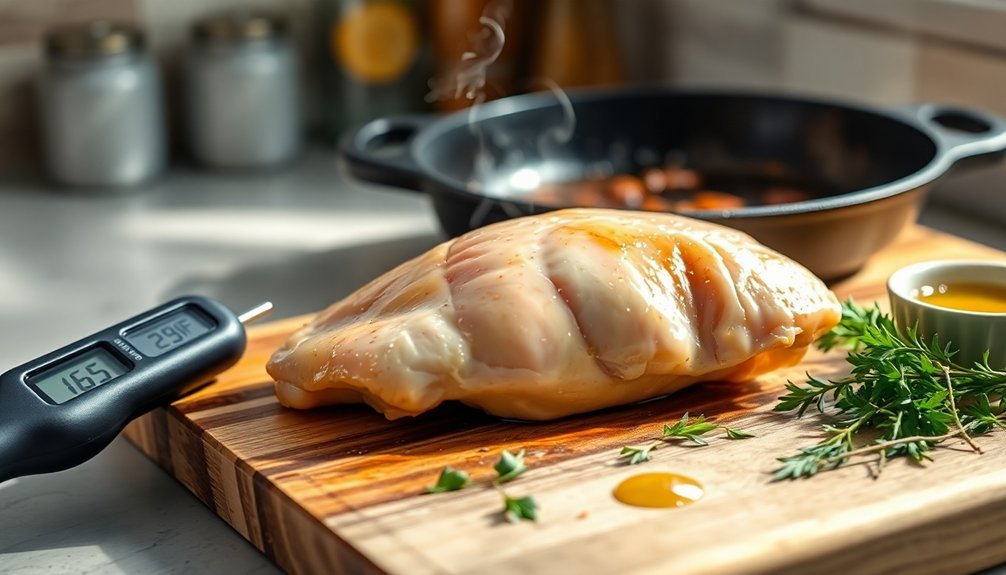
You'll need to master both timing and temperature control to maintain ideal moisture levels in your cooking.
When you're adjusting recipes, remember that lower temperatures typically require longer cooking times, while higher temperatures need shorter durations to prevent moisture loss.
Testing internal temperatures with a food thermometer guarantees you'll achieve the perfect balance of doneness and moisture retention. For optimal results, place larger dishes on the bottom rack where they receive direct heat exposure during extended cooking periods.
Perfect Heat Every Time
Successful cooking relies heavily on mastering the art of temperature and timing adjustments. When you need to modify cooking temperatures, calculate the percentage difference between original and new temperatures to adjust your timing accordingly. For items requiring different temperatures, always set your oven to accommodate the most delicate dish first, then adjust upward once it's done.
- Place delicate items on lower shelves where heat is less intense
- Minimize opening the oven door to maintain consistent temperature
- Space food items properly for even heat distribution
- Start large meats hot, then reduce temperature for thorough cooking
- Check dishes slightly earlier than calculated time to prevent overcooking
Remember that baked goods are less forgiving with temperature adjustments, while savory dishes offer more flexibility.
Consider residual heat when changing temperatures, as it can greatly impact your cooking results.
Adapting Duration For Moisture
Managing moisture levels effectively requires understanding both temperature and time adjustments.
You'll need to account for how temperature impacts relative humidity, especially when heating from cold to warm conditions. When you're pre-heating environments, allow 15-25 minutes to reach ideal conditions at 100°F (38°C).
Monitor your internal temperatures closely and keep doors closed to maintain consistency.
You'll want to adjust your recipe's hydration levels based on your climate – particularly in dry conditions where RH might only be 10-20%.
Remember that heating air reduces relative humidity unless you add moisture. For example, if you heat air from 30°F at 100% RH to 70°F, the RH drops to 24%.
In most heated homes, expect EMC to fluctuate between 6% in winter and 9% in summer.
Temperature Testing Basics
When testing temperatures accurately, proper thermometer calibration and time adjustments become essential for consistent results.
You'll need to verify your thermometer's accuracy by testing it in boiling water, which should read 212°F at sea level. Remember to adjust for altitude by subtracting 1°F for every 500 feet above sea level.
For precise sugar work and deep frying, guarantee you're using the right type of thermometer for your temperature range.
- Check instant-read thermometers for quick measurements between 40°F and 260°F
- Monitor sugar syrups through different stages, from thread (230°F) to hard ball (254°F)
- Watch for smoke points: butter at 250°F, clarified butter at 350°F
- Maintain simmers between 195°F (low) and 210°F (high)
- Adjust cooking times proportionally when changing temperatures, adding a safety margin
Natural Moisture Retention Methods
Natural soil moisture management relies on several effective techniques that work together to keep your garden hydrated.
Start by incorporating organic matter like compost and worm castings, which can hold up to 20 times their weight in water. Well-rotted manure and peat moss are excellent additions for improving water retention.
You'll want to apply a protective layer of mulch over your soil to reduce evaporation and regulate temperature.
Consider combining dense plantings with climbing vegetables to maximize soil shade – squash and pole beans make great companions. Don't forget to maintain proper spacing and remove water-stealing weeds regularly.
For additional moisture control, mix in inorganic additives like vermiculite and perlite.
These materials create essential pore spaces that balance water retention while preventing waterlogging in your garden soil.
Liquid Distribution Strategies
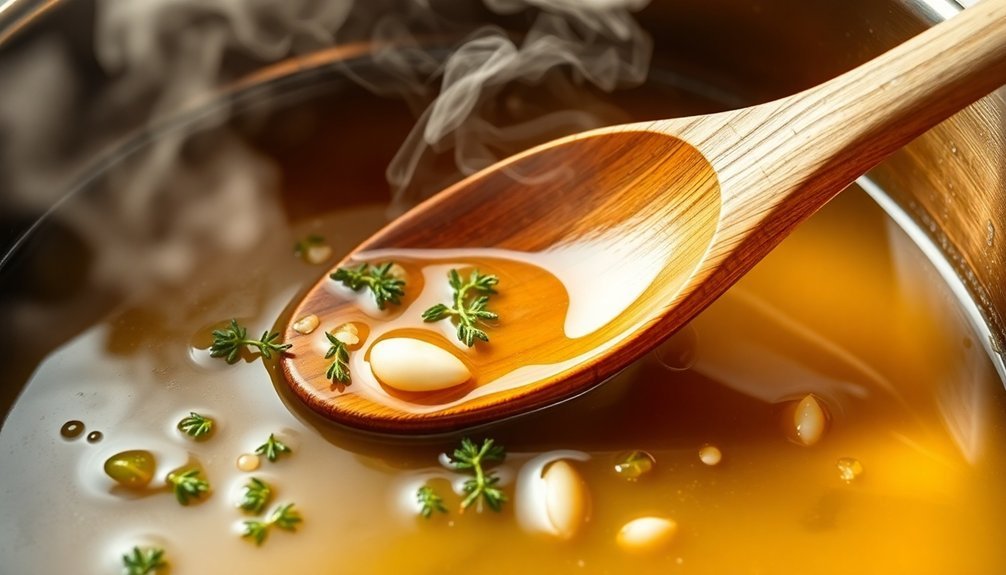
Effective liquid distribution starts with choosing the right method for your garden's specific needs.
You'll want to combine both direct and indirect approaches to guarantee ideal moisture coverage. By integrating technology for real-time tracking, you can monitor water distribution and make adjustments based on demand forecasting.
- Use dual distribution techniques to combine targeted watering with broader coverage areas
- Track moisture levels in real-time using smart irrigation systems
- Partner with local garden centers to learn about region-specific distribution methods
- Establish consistent watering patterns that match your plants' natural cycles
- Integrate automated systems while maintaining hands-on monitoring for best results
Consider your garden's size, plant varieties, and seasonal changes when developing your distribution strategy.
You'll achieve better results by maintaining flexible approaches that can adapt to changing conditions.
Seasonal Cooking Adaptations
You'll need different approaches to manage moisture throughout the seasons, from running dehumidifiers while cooking indoors during humid summers to adding moisture when winter heating systems dry out your kitchen.
Consider moving temperature-sensitive cooking methods outdoors during extreme weather, such as using your grill for high-heat cooking in summer or smoking foods in cooler months.
To maintain ideal moisture levels year-round, invest in equipment like humidity monitors, ventilation fans, and adjustable vent hoods that help you control cooking environments regardless of the season.
Heat Management By Season
Successfully managing heat in the kitchen requires adapting your cooking methods to the changing seasons.
During summer, you'll want to minimize heat generation by using quick-cooking techniques like blanching and steaming, while winter cooking benefits from slow, heat-retaining methods that warm your space.
Adapt your ingredient choices seasonally – opt for light, fresh proteins and vegetables in summer, switching to heartier root vegetables and tough cuts of meat in winter.
- Use ice baths and quick-cooking methods in summer to keep your kitchen cool
- Choose fresh fish and seasonal vegetables during warmer months
- Switch to Dutch ovens and cast-iron cookware in winter for better heat retention
- Embrace slow cooking and braising when temperatures drop
- Let residual heat work for you in both seasons – cooling foods in summer, finishing dishes in winter
Indoor Vs Outdoor Methods
While both indoor and outdoor cooking offer unique advantages throughout the year, knowing when to use each method can dramatically improve your culinary results and comfort level.
In spring, you'll want to use up indoor-preserved foods while preparing your outdoor spaces.
Summer's perfect for outdoor grilling and fresh salads, but you can move indoors when it's too hot.
Fall lets you combine both methods – preserve foods inside while enjoying harvest-season barbecues outside.
You'll appreciate indoor cooking's convenience during winter, with its reliable power and smart appliances.
However, don't overlook outdoor cooking's benefits when weather permits – you'll enjoy better ventilation, more space, and the enhanced flavors from wood-fired ovens or smokers.
Plus, outdoor cooking creates a more social atmosphere that's perfect for entertaining.
Equipment For Climate Control
Proper climate control equipment plays an essential role in both indoor and outdoor cooking environments. For indoor spaces, you'll need systems that regulate temperature, humidity, and airflow precisely.
In outdoor kitchens, focus on weatherproofing solutions and protective measures to maintain ideal cooking conditions despite environmental challenges.
- Install heat lamps or patio heaters strategically around your outdoor cooking area for year-round comfort
- Choose marine-grade HDPE cabinets and rust-proof appliances for outdoor durability
- Set up integrated climate control systems indoors with PLC controls for precise temperature management
- Mount ceiling fans in covered outdoor spaces to improve air circulation on hot days
- Use protective covers for outdoor appliances when they're not in use
These equipment choices help you maintain consistent cooking conditions regardless of the season or weather conditions.
Container Material Selection
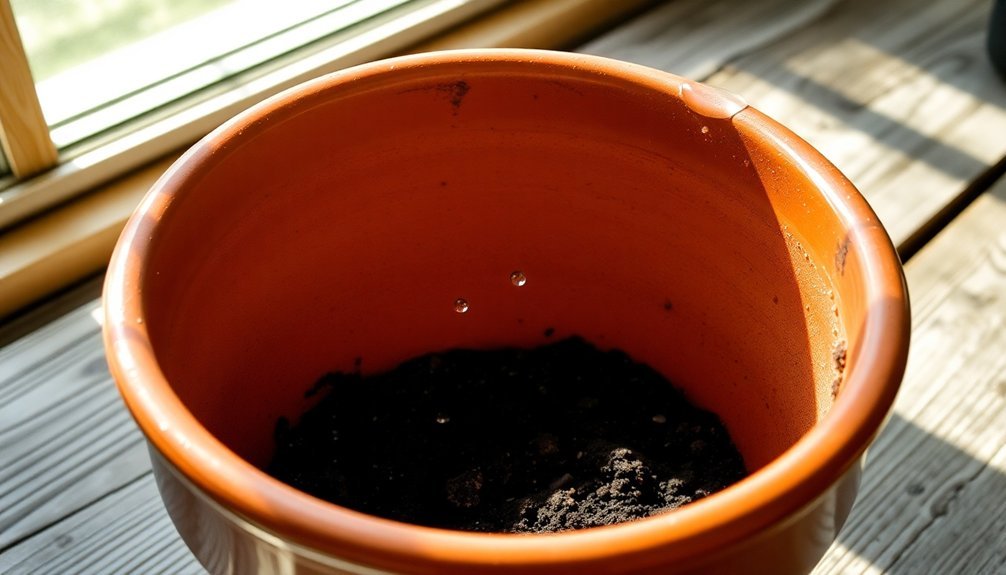
Selecting the right container material plays an essential role in controlling moisture levels for your stored items.
You'll want to choose flexible materials like polyethylene foil, which offers superior durability compared to standard plastic containers while preventing damage from sharp edges.
For ideal moisture control, consider MylarFoil bags or barrier pouches that provide excellent oxygen and moisture resistance.
Make sure your container includes proper ventilation features like grate-style vents or louver vents to maintain consistent airflow and reduce humidity buildup.
When using desiccants, select containers that won't react with materials like calcium chloride or silica gel.
Look for options with insulated walls and aluminum barriers on the floor to prevent moisture accumulation.
Don't forget to check that your chosen container material is compatible with both your desiccant type and stored goods.
Heat Trapping Solutions
You'll maximize moisture retention by using plastic wrap or aluminum foil to create an effective seal that traps steam during cooking.
When wrapping your food, guarantee tight coverage around the edges of your container and consider using a double-layer technique for better insulation.
You can maintain ideal temperatures by adjusting your heat source gradually and using a thermometer to monitor the internal environment, preventing excessive steam loss through overheating.
Sealing Steam While Cooking
When it comes to successful steaming, trapping moisture effectively is crucial for even cooking and ideal results.
You'll want to make sure your lid fits tightly to keep steam circulating properly throughout the cooking process. Using a clear lid lets you monitor your food without releasing precious steam, though you can crack an opaque lid slightly if needed to check progress.
- Fill your pot with just enough liquid to create steam without touching the basket
- Position your steamer basket above the simmering water
- Keep the lid sealed tight to maintain temperatures above 212°F
- Consider cooking "en papillote" for delicate items like fish
- Use flavored liquids like broth or wine to infuse additional taste
Remember that proper steam sealing not only cooks food more efficiently but also helps preserve nutrients that might otherwise be lost through leaching.
Wrapping Methods That Work
Proper wrapping methods can transform your cooking setup into a highly efficient thermal environment. You'll want to start by wrapping your cooking vessel in thick blankets or towels, ensuring there aren't any gaps where heat can escape. Create multiple insulation layers, using materials like rigid foam or reflective surfaces for enhanced effectiveness.
| Material | Benefits | Best Uses |
|---|---|---|
| Blankets | Easy to find, flexible | Outer layer |
| Rigid Foam | High insulation value | Inner layer |
| Reflective Material | Heat reflection | Middle layer |
| Thermal Fabric | Professional results | All-purpose |
For DIY solutions, you can place your wrapped pot in a hay box or insulated container with at least four inches of padding on all sides. Secure everything tightly with straps to maintain consistent heat retention throughout the cooking process.
Temperature Control Techniques
Mastering temperature control starts with understanding the precise heat requirements for different cooking techniques.
You'll need to adjust temperatures based on whether you're sweating vegetables at 285°F, sautéing ingredients at 350°F, or searing proteins at 430°F.
Smart thermometers and professional tools like temperature-controlled pots can help you maintain consistent results across various cooking methods.
- Use two-zone grilling setups to manage both hot-and-fast and low-and-slow cooking
- Monitor heat levels with smart thermometers for real-time temperature feedback
- Switch between direct and indirect heat based on your cooking goals
- Employ precise temperature control tools to replace vague heat settings
- Adjust vent controls on grills to maintain steady cooking temperatures
Moisture Monitoring Tools
Four essential types of moisture monitoring tools help growers measure and track soil moisture levels accurately.
You can start with manual inspection methods, using the feel-and-appearance technique to assess soil samples from different depths.
For basic monitoring, you'll find electrical resistance blocks and probes effective, as they measure moisture through electrical conductivity using portable meters.
If you're looking for real-time data, wireless monitoring sensors offer continuous tracking of soil moisture and temperature through Bluetooth connectivity.
These devices can store thousands of data points and work with various soil types.
For the most precise measurements, you'll want to evaluate advanced sensors like TDR meters, which provide highly accurate readings and can integrate with GPS for mapping.
They're ideal for both indoor and outdoor experiments, operating in extreme temperatures.
Recipe Conversion Guidelines
When scaling recipes up or down for different serving sizes, you'll need to calculate an accurate conversion factor to maintain the right proportions. Divide your desired yield by the original yield to find this factor, then multiply each ingredient by it.
Remember that spices and seasonings don't always scale linearly, so you'll want to adjust them carefully and taste as you go.
- Convert all measurements to consistent units before scaling
- Round final quantities to practical amounts (e.g., 9.99 lbs to 10 lbs)
- Adjust cooking times based on new batch sizes
- Use weight measurements instead of volume when possible
- Consider equipment capacity when increasing recipe size
For precise results, multiply each ingredient quantity by your conversion factor, but be ready to fine-tune seasonings during the final stages of preparation.
Frequently Asked Questions
Can Direct Sunlight Exposure Affect Food Coloring During Solar Cooking?
Yes, direct sunlight can affect your food's color during solar cooking, but you'll notice it's less dramatic than other cooking methods. The slow, gentle heating actually helps preserve most natural food colors.
How Does Altitude Impact Moisture Retention in Solar Cooking Recipes?
At higher altitudes, you'll lose moisture faster due to lower air pressure and quicker evaporation. You'll need to increase your liquid amounts by 10-25% and keep your solar cooker tightly covered during cooking.
Do Electromagnetic Fields From Nearby Electronics Affect Solar Cooking Performance?
You don't need to worry about electromagnetic fields from electronics – they won't affect your solar cooker's performance. The cooking process relies solely on solar radiation and isn't influenced by nearby electronic devices.
What Role Does Lunar Phase Play in Nighttime Moisture Retention?
You'll notice higher moisture retention during full moons due to increased natural light and atmospheric changes. During new moons, you'll experience lower humidity levels as darkness allows for greater cooling and condensation.
Can Solar Reflectors Influence the Mineral Content of Cooked Foods?
Solar reflectors won't directly affect your food's mineral content. They'll just help concentrate heat for cooking, and when combined with gentle solar cooking methods, you'll actually preserve more minerals than harsh cooking techniques.
In Summary
You'll find solar cooking requires careful attention to moisture management, but it's worth mastering. Remember to adjust your liquid ratios, select appropriate lids, and monitor steam levels throughout the cooking process. With these moisture control techniques, you'll transform traditional recipes into solar-friendly versions that retain their flavor and texture. Don't forget to use the right tools and containers – they're essential for successful solar cooking results.

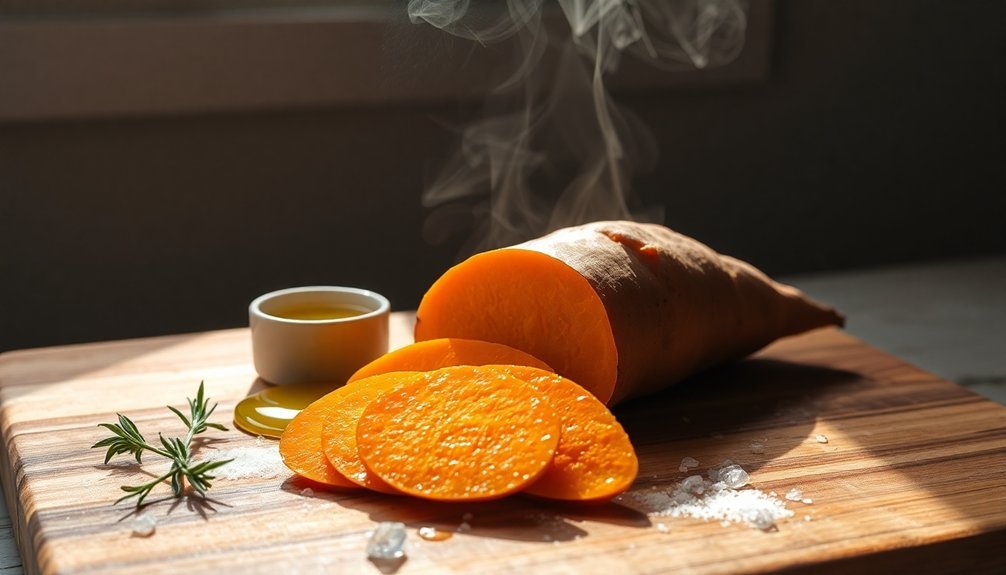



Leave a Reply